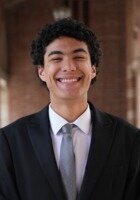All NCLEX-RN Resources
Example Questions
Example Question #201 : General Biology
Which of the following structures passes through the superior orbital fissure?
The superior and inferior divisions of oculomotor nerve (cranial nerve III)
The trochlear nerve (cranial nerve IV)
All of these
The abducens nerve (cranial nerve VI)
The ophthalmic nerve (cranial nerve V, branch V1)
All of these
The superior orbital fissure, an opening in the back of the orbit formed by the lesser and greater wings of the sphenoid bone, has several important structures passing through it. These include the ophthalmic nerve (CN V1), the abducens nerve (CN VI), the trochlear nerve (CN IV), and the superior and inferior divisions of oculomotor nerve (CN III). It also transmits various blood vessels and the sympathetic fivers from the cavernous plexus. Injury to this area can cause a wide range of ocular pathologies including pain, diplopia, ptosis, exophthalmos, and vision impairment or vision loss.
Example Question #201 : General Biology
Which of the following is not a fossa of the scapula?
The subscapular fossa
The infraspinatus fossa
The suprascapular fossa
The supraspinous fossa
The suprascapular fossa
The scapula has multiple fossa that serve as attachment points of various bones and muscles of the shoulder. Among these are the glenoid fossa, where the head of the humerus articulates with the scapula, the subscapular fossa, which is an attachment for the subscapularis muscle, the infraspinous fossa, to which the infraspinatus attaches, and the supraspinous fossa, to which the supraspinatus muscle attaches. There is no suprascapular fossa on the scapula.
Example Question #504 : Nclex
What is the name of the bone that forms the lower part of the jaw?
The maxilla
The frontal bone
The zygomatic bone
The mandible
The mandible
The bone that forms the lower part of the jaw is the mandible. It is the largest and most inferior bone in the face, and articulates with the temporal bones at the temporomandibular joints. The maxilla forms the upper jaw, while the zygomatic bone forms the cheek and part of the orbit.
Example Question #202 : General Biology
All of the following bones of the skull help form the orbit except __________.
the maxilla
The temporal bone
the palatine bone
the sphenoid
The temporal bone
The orbit is formed by the following bones: the maxilla, the zygomatic bone, the frontal bone, the lacrimal bone, the ethmoid, the sphenoid, and the palatine bone. The temporal bone meets the zygomatic and sphenoid but does not form part of the orbit.
Example Question #201 : General Biology
All of the following bones form the nasal cavity except __________.
the nasal bone
the maxilla
the vomer
the sphenoid
the sphenoid
The nasal cavity is formed by the following bones: the maxilla, the vomer, the nasal bone, the palatine bones, the lacrimal bone, and the ethmoid bone. It is also formed by the nasal conchae and the septal cartilage. The sphenoid forms part of the orbit and multiple sinuses but does not form any art of the nasal cavity directly.
Example Question #21 : Musculoskeletal System And Anatomy
You are taking care of a 22-year old basketball player who fractured his clavicle while playing in a game. Which of the following blood vessels is most likely to be compromised by the fractured bone?
Jugular vein
Internal carotid artery
Facial artery
Subclavian artery
External carotid artery
Subclavian artery
The correct answer is "subclavian artery." This is the correct answer because what this question is essentially asking is which of the listed blood vessels is closest to the clavicle, and most likely to be injured by a clavicular fracture based upon its proximity to the clavicle. Of the listed vessels, the subclavian artery is located closest to the clavicle (just inferior to the clavicle bone, as the name, sub-clavian implies). As such, if the clavicle breaks and a sharp fragment is formed, it would be most likely to injure the subclavian artery.
The internal and external carotid arteries, and jugular vein are located within the neck, but more deep and superior to the clavicle than the subclavian artery. The facial artery is located within the face and as such is located very superiorly to the clavicle bone and is unlikely to be involved by a clavicle fracture.
Example Question #21 : Musculoskeletal System And Anatomy
The frontalis muscle does which of the following actions?
Lowers the eyelids
Raises the eyebrows
Furrows the brow
Lifts the eyelids
Raises the eyebrows
The frontalis muscle lifts the eyebrows and wrinkles the forehead. The brow is furrowed by the corrugator supercilii muscle, and the eye lids are raised by the levator palpebrae superioris and lowered by the orbicularis oculi.
Example Question #513 : Nclex
What is the insertion of the masseter?
The temporal bone
The submandibular fossa of the jaw
The coronoid process of the mandible
The mandibular condyle
The coronoid process of the mandible
The masseter is a quadrilateral muscle that originates from the zygomatic arch and maxilla and inserts into the coronoid process of the mandible. It's function is to lift the mandible, closing the jaw.
Example Question #201 : General Biology
What is the function of the risorius?
Retracts the angle of the mouth (smiling)
Depresses the lower lip
Keeps food between the teeth
Purses the lips
Retracts the angle of the mouth (smiling)
The risorius is a small facial muscle that originates on the parotic fascia and inserts into the modiolus. It's primary action is to retract the corners of the mouth in smiling. The lips are pursed by the orbicularis oris. The mouth is compressed and food is kept between the teeth by the buccinator muscle. The lower lip is depressed by the depressor labii inferioris.
Example Question #202 : General Biology
What are the origin and insertion of the orbicularis oris?
The mandibular condyle; the fascia of the masseter
The maxilla and mandible; the skin of the lips
The zygomatic arch; the modiolus
The temporomandibular joint; the buccinator
The maxilla and mandible; the skin of the lips
The orbicularis oris, a circular muscle that compresses the lips, originates on the maxilla and mandible and inserts into the skin of the lips
Certified Tutor
All NCLEX-RN Resources




